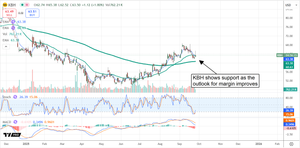
KB Home (NYSE: KBH) has delivered a robust performance in its third-quarter 2024 earnings report, significantly exceeding analyst expectations and sending a positive ripple through the housing market. The homebuilder's strong financial results, coupled with optimistic forward-looking guidance, underscore its operational agility amidst a complex economic landscape characterized by fluctuating mortgage rates and persistent housing supply challenges. This strong showing is not merely a win for KB Home but also offers crucial insights into the broader health and future trajectory of the homebuilding sector.
The impressive earnings report has immediately placed KB Home in the spotlight, highlighting its strategic execution and ability to navigate an environment that has proven challenging for many. The market's initial reaction has been largely favorable, suggesting that investors are keen to reward companies demonstrating resilience and growth potential in an industry grappling with affordability concerns and evolving consumer demand.
KB Home's Q3 Triumph: What Happened and Why it Matters
On September 24, 2024, KB Home (NYSE: KBH) unveiled its third-quarter financial results for the period ending August 31, 2024, revealing a performance that surpassed even the most optimistic analyst predictions. The company reported a diluted earnings per share (EPS) of $2.04, marking a substantial 13% increase year-over-year and comfortably beating the consensus estimate. Total revenues climbed 10% to $1.75 billion, also exceeding analyst forecasts. This strong financial output is a testament to KB Home's effective management and strategic positioning.
Several key metrics underpinned this success. Homes delivered rose by 8% to 3,631 units, with the average selling price (ASP) seeing a 3% increase to $480,900. The company's homebuilding operating income grew by 5% to $189.0 million, maintaining a healthy operating income margin. Despite a slight dip in housing gross profit margin, improved selling, general, and administrative (SG&A) expenses as a percentage of housing revenues demonstrated enhanced operating leverage. Furthermore, net orders remained stable, with a 2% increase in net order value, driven by a higher ASP for new orders. The company also actively repurchased $150.0 million of common stock, signaling confidence in its valuation. These results are particularly significant as they reflect the company's ability to maintain growth and profitability despite a variable demand environment, which saw some softening in early summer before an improvement in August as mortgage rates moderated.
The Market's Response and Potential Ripple Effects
Following the announcement of its stellar Q3 2024 earnings, KB Home's (NYSE: KBH) stock price experienced a significant uplift. Shares gained 3.0% the day after the announcement, closing at $53.09, and continued to drift higher by an additional 24.7% over the subsequent 82 days. This robust positive movement underscores a favorable market reaction, indicating investor confidence in the company's financial health and future prospects. Such a strong performance from a major homebuilder like KB Home can have a notable impact on the broader market sentiment towards the housing sector.
Companies that might "win" from KB Home's success include other large, well-capitalized homebuilders such as Lennar Corporation (NYSE: LEN), D.R. Horton, Inc. (NYSE: DHI), and PulteGroup, Inc. (NYSE: PHM). A strong showing by one industry leader often suggests underlying positive trends that could benefit its peers, especially if they share similar operational efficiencies or market strategies. Additionally, suppliers of building materials and home furnishings could see increased demand if positive sentiment translates into sustained home construction activity.
Conversely, companies that might "lose" or face challenges are those less equipped to adapt to the evolving market dynamics. Smaller, regional builders with less financial flexibility or those heavily reliant on specific, highly sensitive local markets might struggle to compete with the operational scale and strategic agility demonstrated by companies like KB Home. The sustained success of larger players could intensify competition, potentially squeezing profit margins for less efficient operators.
Broader Implications for the Housing Industry
KB Home's (NYSE: KBH) strong Q3 performance arrives amidst a homebuilding sector characterized by a fascinating dichotomy: persistent challenges intertwined with cautious optimism. While the broader market continues to grapple with elevated mortgage rates, high home prices, and a lingering shortage of existing homes for sale, the new home market has shown remarkable resilience. KB Home's results reinforce this trend, demonstrating that well-managed builders can not only survive but thrive by adapting to current conditions.
The company's success highlights the effectiveness of builder-led incentives, such as mortgage rate buydowns and closing cost assistance, in attracting buyers in a price-sensitive environment. This strategy has become a crucial differentiator for new home sales compared to the stagnant existing home market, where a "lock-in effect" discourages homeowners with low mortgage rates from selling. KB Home's ability to drive sales and increase average selling prices suggests that strategic incentives, coupled with efficient construction, are key to unlocking demand.
Looking ahead, the industry is closely watching for potential shifts in monetary policy. The Federal Reserve's cautious approach to interest rates, and the possibility of future rate declines, could significantly ease affordability concerns and further boost demand for new homes. Historical precedents suggest that even modest reductions in mortgage rates can unleash pent-up demand, creating a more favorable environment for homebuilders. Furthermore, regulatory and policy implications, particularly those related to land use, zoning, and construction costs, will continue to shape the industry's trajectory. Any policy changes aimed at increasing housing supply or reducing development costs could provide additional tailwinds for the sector.
What Readers Should Pay Attention to Next
As KB Home (NYSE: KBH) continues to navigate the dynamic housing market, investors and industry observers should closely monitor several key areas. The company's forward-looking guidance for the full year 2024, including projected housing revenues between $6.85 billion and $6.95 billion and an average selling price of approximately $490,000, provides a clear roadmap. The anticipated housing gross profit margin and operating income as a percentage of revenues will be crucial indicators of sustained profitability. For the fourth quarter of 2024, KB Home projects housing revenues between $1.94 billion and $2.04 billion, and its expectation of approximately $7.5 billion in housing revenues for 2025 signals robust growth ambitions.
A significant factor to watch is the trajectory of mortgage rates. KB Home's management has expressed optimism for a strong spring selling season in 2025, largely predicated on the expectation of lower borrowing costs. Any moderation in interest rates could significantly enhance affordability and stimulate buyer demand, directly impacting KB Home's ability to meet its ambitious delivery targets. Additionally, continued improvements in construction cycle times and lower cancellation rates, as noted by the company, will be vital for operational efficiency and sustained growth.
Potential strategic pivots or adaptations required by homebuilders in response to evolving market conditions are also worth observing. This includes continued innovation in home design, energy efficiency, and community development to meet changing consumer preferences. Market opportunities may emerge in specific geographic regions or product segments, such as entry-level or active adult communities, where demand remains strong. Conversely, challenges related to labor shortages, material costs, and regulatory hurdles could impact profitability.
Conclusion
KB Home's (NYSE: KBH) third-quarter 2024 earnings report stands as a powerful testament to the company's operational strength and strategic acumen in a challenging yet evolving housing market. By exceeding analyst expectations and providing an optimistic outlook, KB Home has not only reinforced its position as a leading homebuilder but also offered a glimpse into the potential resilience and adaptability of the broader industry. The company's ability to drive growth through increased deliveries, higher average selling prices, and efficient cost management provides a compelling narrative for investors.
Moving forward, the housing market will continue to be influenced by a confluence of macroeconomic factors, most notably the direction of mortgage rates and the overall health of the economy. KB Home's proactive approach, including its focus on managing construction cycles and leveraging incentives, positions it well to capitalize on potential market improvements. Investors should closely watch for continued signs of moderating interest rates, which could unlock further demand and accelerate the recovery of the housing sector. The spring selling season of 2025 will be a critical period, offering insights into the true strength of buyer sentiment and the effectiveness of builder strategies. KB Home's performance will serve as a bellwether, providing valuable signals for the entire industry in the coming months.
This content is intended for informational purposes only and is not financial advice





